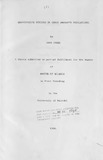| dc.description.abstract | Twenty-two grain amaranth populations were subjected to comparative evaluation for the number of days to flowering, the number of leaves on the main stem, the number of leaves on the main branches, leaf length, leaf width, the number of days to maturity,
plant height, plant weight, seed yield and harvest index in a randomised block design during the short rains of 1986 and
long rains of 1987 at Kabete. The populations were Jumla,
125A, 1024, 718, UNK47 , UNK44 , 723, 674, 1023, 1008, 51,
84, 862, and 812 (all Amaranthus hypochondriacus); 1011,
434, UC87, and UC100 A. cruentus) 1113A and 982 (A. caudatus)f 1004 and 386 CA. hybridus). The results indicated that A. cruentus gave the highest means for the number of leaves on the main stem, leaf length, leaf width, plant height, plant weight and seed yield. A.
hybridus gave the highest means for harvest index and the lowest means for the number of days to flowering, and the number of days to maturity, while A.caudatus gave the highest mean for the number of leaves on the main branches.
Six of the above populations, namely, Jumla, 1023, 434, 1011, 982 and 1113A were investigated for within population variation for the above traits by planting eight Sl families from each population in a
three-replicate compact family block design at Kabete in 1987. The amount of variability inherent within each of the six populations varied for the various traits.
Population 1011 was the most heterogenous population as it showed significant variation among the families for all the traits except the number of days to flowering.
Population 434 was the least variable population as it showed significant variation among its families for leaf length only. Population Jumla had significant variation for all the other traits except plant weight, the number of days to maturity and the number of leaves on the main stem. Population 1023 showed significant variability for the number of days to flowering, the number of days
to maturity, leaf width, plant height and plant weight.
Population 982 showed significant variation for the number
of leaves on the main stem, the number of leaves on the main branches, leaf length, leaf width and plant height. Population 1113A showed significant variation for only four traits, namely, the number of days to flowering, the number of leaves on the main stem, plant
height and seed yield.
The variability within the populations was reflected in the values of broad sense heritability and selection response estimates which were estimated for each population separately. Traits like the number of leaves on the main stem, leaf length, leaf width, and
plant height had high heritability estimates in population
1011. Likewise high expected selection response estimates were obtained for seed yield in populations Jumla, and 1113A, and the number of days to flowering in populations 1023 and 1113A.
The data from the six populations were subjected to phenotypic, correlation and path-coefficient analyses to help identify the best metric traits that can be used as seed yield predictors. The data indicated that the highly heritable traits such as leaf length, plant height and plant weight in population 1011; leaf width in Jumla
and plant height in population 1023 had high positive correlations with seed yield. All the traits except the number of days to maturity and the number of days to flowering in all populations and plant height in population 434 correlated positively with seed yield in the
Sl populations. The results also showed that bigger plants with higher total dry matter productivity had higher seed yields as is indicated by the high positive correlations of seed yield with the number of leaves, leaf length, leaf width and plant weight.
Based on the correlations and path-coefficients, plant weight and harvest index were found to be the best positive indicators of plant yield | |

